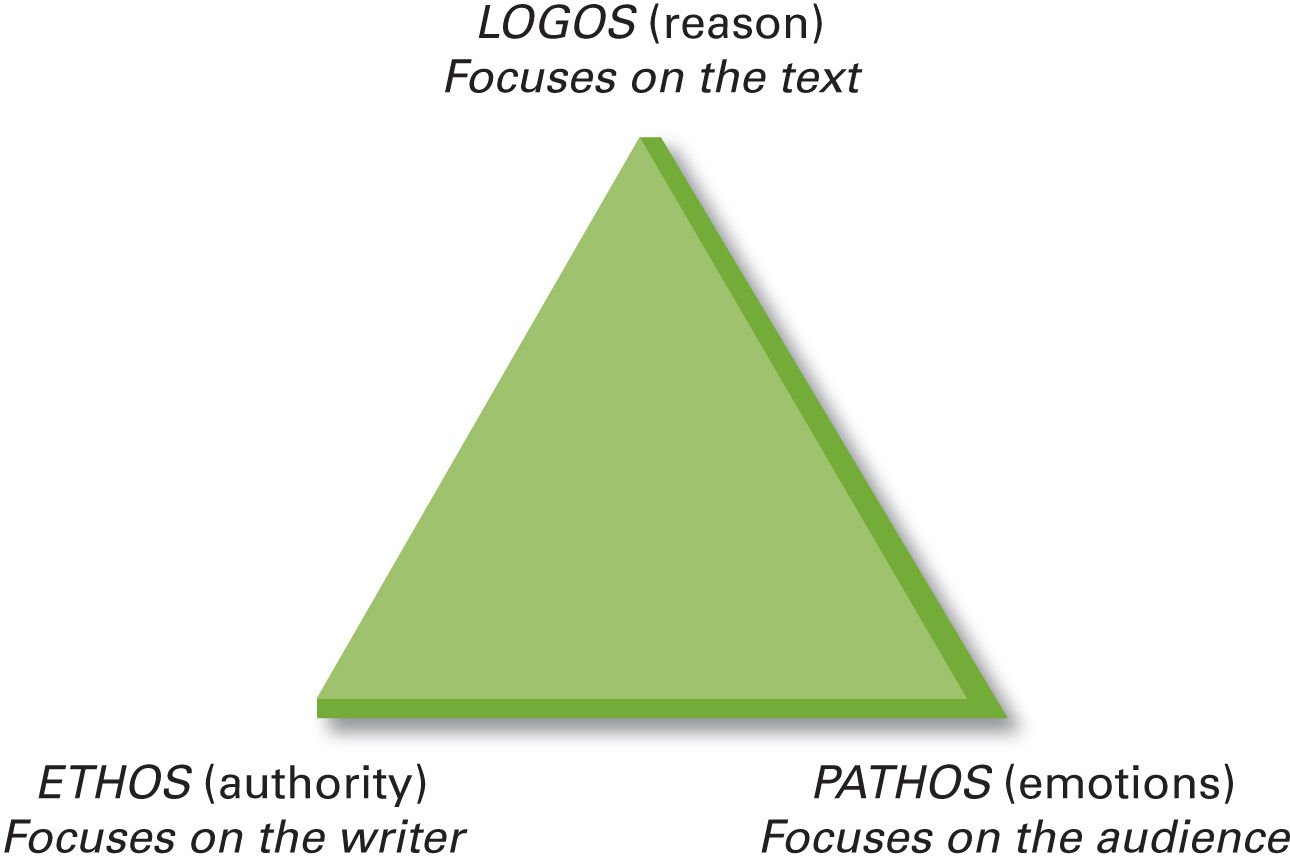
Ron Chapple/Getty Images

Ron Chapple/Getty Images
Arguments are everywhere. Whenever you turn on the television, read a newspaper or magazine, talk to friends and family, enter an online discussion, or engage in a debate in one of your classes, you encounter arguments. In fact, it is fair to say that much of the interaction that takes place in society involves argument. Consider, for example, a lawyer who tries to persuade a jury that a defendant is innocent, a doctor who wants to convince a patient to undergo a specific form of treatment, a lawmaker who wants to propose a piece of legislation, an executive who wants to institute a particular policy, an activist who wants to pursue a particular social agenda, a parent who wants to convince a child to study harder, a worker who wants to propose a more efficient way of performing a task, an employee who thinks that he or she deserves a raise, or a spokesperson in an infomercial whose goal is to sell something: all these people are engaging in argument.
In college, you encounter arguments on a daily basis; in fact, both class discussions and academic writing often take the form of argument. Consider, for example, the following questions that might be debated (and written about) in a first-year writing class:
Do the benefits of fracking outweigh its risks?
How free should free speech be?
Are helicopter parents ruining their children’s lives?
How far should schools go to keep students safe?
Do bystanders have an ethical responsibility to help in a crisis?
What these questions have in common is that they all call for argumentation. To answer these questions, students would be expected to state their opinions and support them.
Now for the obvious question: exactly what is an argument? Perhaps the best way to begin is by explaining what argument is not. An argument (at least an academic argument) is not a quarrel or an angry exchange. The object of argument is not to attack someone who disagrees with you or to beat an opponent into submission. For this reason, the shouting matches that you routinely see on television or hear on talk radio are not really arguments. Argument is also not spin —the positive or biased slant that politicians routinely put on facts—or propaganda —information (or misinformation) that is spread to support a particular viewpoint. Finally, argument is not just a contradiction or denial of someone else’s position. Even if you establish that an opponent’s position is wrong or misguided, you still have to establish that your own position has merit by presenting evidence to support it.

World War I propaganda poster (1917)
Wake Up, America! (1917) James Montgomery Flagg. Published by the Hegeman Print, New York/Library of Congress Prints and Photographs Division [LC-USZC4-3802].
There is a basic difference between formal arguments —those that you develop in academic discussion and writing—and informal arguments —those that occur in daily life, where people often get into arguments about politics, sports, social issues, and personal relationships. These everyday disputes are often just verbal fights in which one person tries to outshout another. Although they sometimes include facts, they tend to rely primarily on emotion and unsupported opinions. Moreover, such everyday arguments do not have the formal structure of academic arguments: they do not establish a logical link between a particular viewpoint and reliable supporting evidence. There is also no real effort to address opposing arguments. In general, these arguments tend to be disorganized, emotional disputes that have more to do with criticizing an opponent than with advancing and supporting a position on an issue. Although such informal arguments can serve as starting points for helping you think about issues, they do not have the structure or the intellectual rigor of formal arguments.
So exactly what is an argument—or, more precisely, what is an academic argument? An academic argument is a type of formal argument that takes a stand, presents evidence, includes documentation, and uses logic to convince an audience to accept (or at least consider) the writer’s position. Of course, academic arguments can get heated, but at their core they are civil exchanges. Writers of academic arguments strive to be fair and to show respect for others—especially for those who present opposing arguments.
Keep in mind that arguments take positions with which reasonable people may disagree. For this reason, an argument never actually proves anything. (If it did, there would be no argument.) The best that an argument can do is to convince other people to accept (or at least acknowledge) the validity of its position.

An angry exchange is not an academic argument.
Flying Colours Ltd./Getty Images
It is a mistake to think that all arguments have just two sides—one right side and one wrong side. In fact, many arguments that you encounter in college focus on issues that are quite complex. For example, if you were considering the question of whether the United States should ban torture, you could certainly answer this question with a yes or a no, but this would be an oversimplification. To examine the issue thoroughly, you would have to consider it from a number of angles:
Should torture be banned in all situations?
Should torture be used as a last resort to elicit information that could prevent an imminent attack?
What actually constitutes torture? For example, is sleep deprivation torture? What about a slap on the face? Loud music? A cold cell? Are “enhanced interrogation techniques”—such as waterboarding—torture?
Who should have the legal right to approve interrogation techniques?
If you were going to write an argument about this issue, you would have to take a position that adequately conveyed its complex nature—for example, “Although torture may be cruel and even inhuman, it is sometimes necessary.” To do otherwise might be to commit the either/or fallacy (see p. 151)—to offer only two choices when there are actually many others.
In blogs, social media posts, work-related proposals, letters to the editor, emails to businesses, letters of complaint, and other types of communication, you formulate arguments that are calculated to influence readers. Many everyday situations call for argument:
A proposal to the manager of the UPS store where you work to suggest a more efficient way of sorting packages
A letter to your local newspaper in which you argue that creating a walking trail would be good use of your community’s tax dollars
An email to your child’s principal asking her to extend after-school hours
A letter to a credit card company in which you request an adjustment to your bill
A blog post in which you argue that the federal government could do more to relieve the student loan burden
Because argument is so prevalent, the better your arguing skills, the better able you will be to function—not just in school but also in the wider world. When you have a clear thesis, convincing support, and effective refutation of opposing arguments, you establish your credibility and go a long way toward convincing readers that you are someone worth listening to.
Presenting a good argument does not guarantee that readers will accept your ideas. It does, however, help you to define an issue and to express your position clearly and logically. If you present yourself as a well-informed, reasonable person who is attuned to the needs of your readers—even those who disagree with you—you increase your chances of convincing your audience that your position is worth considering.
Arguments are also central to our democratic form of government. Whether the issue is taxation, health care, border control, the environment, abortion, gun ownership, energy prices, gay marriage, terrorism, or cyberbullying, political candidates, media pundits, teachers, friends, and family members all try to influence the way we think. So in a real sense, argument is the way that all of us participate in the national (or even global) conversation about ideas that matter. The better you understand the methods of argumentation, the better able you will be to recognize, analyze, and respond to the arguments that you hear. By mastering the techniques of argument, you will become a clearer thinker, a more informed citizen, and a person who is better able to influence those around you.

Black Lives Matter protest
Andrew Burton/Getty Images
People often talk of “winning” and “losing” arguments, and of course, the aim of many arguments is to defeat an opponent. In televised political debates, candidates try to convince viewers that they should be elected. In a courtroom, a defense attorney tries to establish a client’s innocence. In a job interview, a potential employee tries to convince an employer that he or she is the best-qualified applicant. However, the goal of an argument is not always to determine a winner and a loser. Sometimes the goal of an argument is to identify a problem and suggest solutions that could satisfy those who hold a number of different positions on an issue.
If, for example, you would like your college bookstore to lower the price of items (such as sweatshirts, coffee mugs, and backpacks) with a school logo, you could simply state your position and then support it with evidence. A more effective way of approaching this problem, however, might be to consider all points of view and find some middle ground. For example, how would lowering these prices affect the bookstore? A short conversation with the manager of the bookstore might reveal that the revenue generated by these products enables the bookstore to discount other items—such as art supplies and computers—as well as to hire student help. Therefore, decreasing the price of products with college logos would negatively affect some students. Even so, the high prices also make it difficult for some students to buy these items.
To address this problem, you could offer a compromise solution: the price of items with college logos could be lowered, but the price of other items—such as magazines and snacks—could be raised to make up the difference.
In everyday use, the term rhetoric has distinctly negative connotations. When a speech is described as being nothing but rhetoric, the meaning is clear: the speech consists of empty words and phrases calculated to confuse and manipulate listeners. When writing instructors use the term rhetoric, however, it means something quite different: it refers to the choices someone makes to structure a message—written, oral, or visual.
The rhetorical situation refers to the factors that influence the creation of any type of communication—especially its words, images, and structure. Applied to argument, the rhetorical situation refers to five factors you should consider when planning an effective argument. Although every rhetorical situation is different, all rhetorical situations involve the following five elements:
The writer
The purpose
The audience
The question
The context
Every argument begins with a writer, the person who creates the text. For this reason, it is important to understand how your biases or preconceptions could affect what you produce. For example, if you were home schooled, you might have very definite ideas about education. Likewise, a former Navy Seal might have preconceptions concerning the war in Afghanistan. Strongly held beliefs like these can, and often do, color your arguments. The following factors can affect the tone and content of an argument:
Before you plan an argument, ask yourself what preconceived ideas you may have about a particular topic. Do your beliefs prevent you from considering all sides of an issue, reaching a logical and fair conclusion, or acknowledging the validity of opposing arguments? It is important that you present yourself as a fair and open-minded person, one whom readers trust. For this reason, you should maintain a reasonable tone and avoid the use of words or phrases that indicate bias.
A writer’s purpose is his or her reason for writing. The purpose of an argument is to present a position and to change (or at least influence) people’s ideas about an issue. In addition to this general purpose, a writer may have more specific goals. For example, you might want to criticize the actions of others or call into question a particular public policy. You may also want to take a stand on a controversial topic or convince readers that certain arguments are weak. Finally, you may want to propose a solution to a problem or convince readers to adopt a certain course of action.
When you write an argument, you may want to state your purpose directly—usually in your introduction. (Key words in your thesis statement can indicate the direction the argument will take as well as the points that you will discuss.) At other times, especially if you think readers will not readily accept your ideas, you may want to indicate your purpose later in your essay or simply imply it.
When you write argumentative essays, you don’t write in a vacuum; you write for real people who may or may not agree with you. As you are writing, it is easy to forget this fact and address a general group of readers. However, doing this would be a mistake. Defining your audience and keeping this audience in mind as you write is important because it helps you decide what material to include and how to present it.
One way to define an audience is by its traits —the age, gender, interests, values, preconceptions, and level of education of audience members. Each of these traits influences how audience members will react to your ideas, and understanding them helps you determine how to construct your argument. For instance, suppose you were going to write an essay with the following thesis:
Although college is expensive, its high cost is justified.
How you approach this subject would depend on the audience you were addressing. For example, college students, parents, and college administrators would have different ideas about the subject, different perspectives, different preconceptions, and different levels of knowledge. Therefore, the argument you write for each of these audiences would be different from the others in terms of content, organization, and type of appeal.
College students have a local and personal perspective. They know the school and have definite ideas about the value of the education they are getting. Most likely, they come from different backgrounds and have varying financial needs. Depending on their majors, they have different expectations about employment (and salary) when they graduate. Even with these differences, however, these students share certain concerns. Many probably have jobs to help cover their expenses. Many also have student loans that they will need to start paying after graduation.
An argumentative essay addressing this audience could focus on statistics and expert opinions that establish the worth of a college degree in terms of future employment, job satisfaction, and lifetime earnings.
Parents probably have limited knowledge of the school and the specific classes their children are taking. They have expectations—both realistic and unrealistic—about the value of a college degree. Some parents may be able to help their children financially, and others may be unable to do so. Their own life experiences and backgrounds probably color their ideas about the value of a college education. For example, parents who have gone to college may have different ideas about the value of a degree from those who haven’t.
An argumentative essay addressing this audience could focus on the experience of other parents of college students. It could also include statistics that address students’ future economic independence and economic security.
College administrators have detailed knowledge about college and the economic value of a degree. They are responsible for attracting students, scheduling classes, maintaining educational standards, and providing support services. They are familiar with budget requirements, and they understand the financial pressures involved in running a school. They also know how tuition dollars are spent and how much state and federal aid the school needs to stay afloat. Although they are sympathetic to the plight of both students and parents, they have to work with limited resources.
An argumentative essay addressing this audience could focus on the need to make tuition more affordable by cutting costs and providing more student aid.
Another way to define an audience is to determine whether it is friendly, hostile, or neutral.
A friendly audience is sympathetic to your argument. This audience might already agree with you or have an emotional or intellectual attachment to you or to your position. In this situation, you should emphasize points of agreement and reinforce the emotional bond that exists between you and the audience. Don’t assume, however, that because this audience is receptive to your ideas, you do not have to address its concerns or provide support for your points. If readers suspect that you are avoiding important issues or that your evidence is weak, they will be less likely to take your argument seriously—even though they agree with you.
A hostile audience disagrees with your position and does not accept the underlying assumptions of your argument. For this reason, you have to work hard to overcome their preconceived opinions, presenting your points clearly and logically and including a wide range of evidence. To show that you are a reasonable person, you should treat these readers with respect even though they happen to disagree with you. In addition, you should show that you have taken the time to consider their arguments and that you value their concerns. Even with all these efforts, however, the best you may be able to do is get them to admit that you have made some good points in support of your position.
A neutral audience has no preconceived opinions about the issue you are going to discuss. (When you are writing an argument for a college class, you should assume that you are writing for a neutral audience.) For this reason, you need to provide background information about the issue and about the controversy surrounding it. You should also summarize opposing points of view, present them logically, and refute them effectively. This type of audience may not know much about an issue, but it is not necessarily composed of unsophisticated or unintelligent people. Moreover, even though such readers are neutral, you should assume that they are skeptical —that is, that they will question your assumptions and require supporting evidence before they accept your conclusions.
Keep in mind that identifying a specific audience is not something that you do at the last minute. Because your audience determines the kind of argument you present, you should take the time to make this determination before you begin to write.
All arguments begin with a question that you are going to answer. To be suitable for argument, this question must have more than one possible answer. If it does not, there is no basis for the argument. For example, there is no point trying to write an argumentative essay on the question of whether head injuries represent a danger for football players. The answer to this question is so obvious that no thoughtful person would argue that they are not. The question of whether the National Football League is doing enough to protect players from head injuries, however, is one on which reasonable people could disagree. Consider the following information:
In recent years, the NFL has done much to reduce the number of serious head injuries.
New protocols for the treatment of players who show signs of head trauma, stricter rules against helmet-to-helmet tackles, and the use of safer helmets have reduced the number of concussions.
Even with these precautions, professional football players experience a high number of head injuries, with one in three players reporting negative effects—some quite serious—from repeated concussions.
Because there are solid arguments on both sides of this issue, you could write an effective argument in which you address this question.
An argument takes place in a specific context —the set of circumstances that surrounds the issue. As you plan your argument, consider the social, historical, and cultural events that define the debate.
Assume that you were going to argue that the public school students in your hometown should be required to purchase iPads. Before you begin your argument, you should give readers the background—the context—they will need to understand the issue. For example, they should know that school officials have been debating the issue for over a year. School administrators say that given the advances in distance learning as well as the high quality of online resources, iPads will enhance the educational experience of students. They also say that it is time to bring the schools’ instructional methods into the twenty-first century. Even so, some parents say that requiring the purchase of iPads will put an undue financial burden on them. In addition, teachers point out that a good deal of new material will have to be developed to take advantage of this method of instruction. Finally, not all students will have access at home to the high-speed Internet capacity necessary for this type of instruction.
If it is not too complicated, you can discuss the context of your argument in your introduction; if it requires more explanation, you can discuss it in your first body paragraph. If you do not establish this context early in your essay, however, readers will have a difficult time understanding the issue you are going to discuss and the points you are going to make.

Aristotle
Aristotle, Roman portrait bust. Scala/Ministero per i Beni e le Attività Culturali/Uffizi Gallery, Florence, Italy/Art Resource, NY.
To be effective, your argument has to be persuasive. Persuasion is a general term that refers to how a speaker or writer influences an audience to adopt a particular belief or to follow a specific course of action.
In the fifth century BCE, the philosopher Aristotle considered the issue of persuasion. Ancient Greece was primarily an oral culture (as opposed to a written or print culture), so persuasive techniques were most often used in speeches. Public officials had to speak before a citizens’ assembly, and people had to make their cases in front of various judicial bodies. The more persuasive the presentation, the better the speaker’s chance of success. In The Art of Rhetoric, Aristotle examines the three different means of persuasion that a speaker can use to persuade listeners (or writers):
The appeal to reason (logos)
The appeal to the emotions (pathos)
The appeal to authority (ethos)
According to Aristotle, argument is the appeal to reason or logic (Logos). He assumed that, at their core, human beings are logical and therefore would respond to a well-constructed argument. For Aristotle, appeals to reason focus primarily on the way that an argument is organized, and this organization is determined by formal logic, which uses deductive and inductive reasoning to reach valid conclusions. Aristotle believed that appeals to reason convince an audience that a conclusion is both valid and true (see Chapter 5 for a discussion of deductive and inductive reasoning and logic). Although Aristotle believed that ideally, all arguments should appeal to reason, he knew that given the realities of human nature, reason alone was not always enough. Therefore, when he discusses persuasion, he also discusses the appeals to ethos and pathos.
Notice how the ad below for the Toyota Prius, a popular hybrid automobile, appeals primarily to reason. It uses facts as well as a logical explanation of how the car works to appeal to reason (as well as to the consumer’s desire to help the environment).

Car shot for Toyota Prius Harmony ad © Trevor Pearson. Background for Toyota Prius Harmony ad © Mark Holthusen Photography. Reproduced with permission of the photographers and Toyota Sales USA.
You can assess the effectiveness of logos (the appeal to reason) in an argument by asking the following questions:
Does the argument have a clear thesis? In other words, can you identify the main point the writer is trying to make?
Does the argument include the facts, examples, and expert opinion needed to support the thesis?
Is the argument well organized? Are the points the argument makes presented in logical order?
Can you detect any errors in logic (fallacies) that undermine the argument’s reasoning?
Aristotle knew that an appeal to the emotions (Pathos) could be very persuasive because it adds a human dimension to an argument. By appealing to an audience’s sympathies and by helping them to identify with the subject being discussed, emotional appeals can turn abstract concepts into concrete examples that can compel people to take action. After December 7, 1941, for example, explicit photographs of the Japanese attack on Pearl Harbor helped convince Americans that retaliation was both justified and desirable. Many Americans responded the same way when they saw pictures of planes crashing into the twin towers of the World Trade Center on September 11, 2001.
Although an appeal to the emotions can add to an already strong argument, it does not in itself constitute proof. Moreover, certain kinds of emotional appeals—appeals to fear, hatred, and prejudice, for example—are considered unfair and are not acceptable in college writing. In this sense, the pictures of the attacks on Pearl Harbor and the World Trade Center would be unfair arguments if they were not accompanied by evidence that established that retaliation was indeed necessary.
The following ad makes good use of the appeal to the emotions. Using a picture of polar bears defaced by graffiti, the ad includes a caption encouraging people to respect the environment. Although the ad contains no supporting evidence, it is effective nonetheless.

Courtesy of WWF.org, reproduced with permission
You can assess the effectiveness of pathos (the appeal to the emotions) in an argument by asking the following questions:
Does the argument include words or images designed to move readers?
Does the argument use emotionally loaded language?
Does the argument include vivid descriptions or striking examples calculated to appeal to readers’ emotions?
Are the values and beliefs of the writer apparent in the argument?
Does the tone seem emotional?
Finally, Aristotle knew that the character and authority of a speaker or writer (ethos) could contribute to the persuasiveness of an argument. If the person making the argument is known to be honorable, truthful, knowledgeable, and trustworthy, audiences will likely accept what he or she is saying. If, on the other hand, the person is known to be deceitful, ignorant, dishonest, uninformed, or dishonorable, audiences will probably dismiss his or her argument—no matter how persuasive it might seem. Whenever you analyze an argument, you should try to determine whether the writer is worth listening to—in other words, whether the writer has credibility. (For a discussion of how to establish credibility and demonstrate fairness in your own writing, see Chapter 7.)
The following ad uses an appeal to authority. It uses an endorsement by the popular tennis star Venus Williams to convince consumers to buy Reebok sneakers. (Recent studies suggest that consumers react positively to ads that feature products endorsed by famous athletes.)
You can assess the effectiveness of ethos (the appeal to authority) in an argument by asking the following questions:
Does the person making the argument demonstrate knowledge of the subject?
What steps does the person making the argument take to present its position as reasonable?
Does the argument seem fair?
If the argument includes sources, do they seem both reliable and credible? Does the argument include proper documentation?
Does the person making the argument demonstrate respect for opposing viewpoints?

Venus Williams in an ad endorsing Reebok
AP Photo/Kathy Willens
The relationship among the three kinds of appeals in an argument is traditionally represented by a triangle.

In the diagram above—called the rhetorical triangle —all sides of the triangle are equal, implying that the three appeals occur in an argument in equal measure. In reality, however, this is seldom true. Depending on the audience, purpose, and situation, an argument may include all three appeals or just one or two. Moreover, one argument might emphasize reason, another might stress the writer’s authority (or credibility), and still another might appeal mainly to the emotions. (In each of these cases, one side of the rhetorical triangle would be longer than the others.) In academic writing, for example, the appeal to reason is used most often, and the appeal to the emotions is less common. As Aristotle recognized, however, the three appeals often work together (to varying degrees) to create an effective argument.
Each of the following paragraphs makes an argument against smoking, illustrating how the appeals are used in an argument. Although each paragraph includes all three of the appeals, one appeal outweighs the others. (Keep in mind that each paragraph is aimed at a different audience.)
APPEAL TO REASON (LOGOS)
Among young people, the dangers of smoking are clear. According to the World Health Organization, smoking can cause a variety of problems in young people—for example, lung problems and shortness of breath. Smoking also contributes to heart attacks, strokes, and coronary artery disease (72). In addition, teenage smokers have an increased risk of developing lung cancer as they get older (CDC). According to one study, teenage smokers see doctors or other health professionals at higher rates than those who do not smoke (Ardly 112). Finally, teenagers who smoke tend to abuse alcohol and marijuana as well as engage in other risky behaviors (CDC). Clearly, tobacco is a dangerous drug that has serious health risks for teenage smokers. In fact, some studies suggest that smoking takes thirteen to fourteen years off a person’s life (American Cancer Society).
APPEAL TO THE EMOTIONS (PATHOS)
Every day, almost four thousand young people begin smoking cigarettes, and this number is growing (Family First Aid). Sadly, most of you have no idea what you are getting into. For one thing, smoking yellows your teeth, stains your fingers, and gives you bad breath. The smoke also gets into your hair and clothes and makes you smell. Also, smoking is addictive; once you start, it’s hard to stop. After you’ve been smoking for a few years, you are hooked, and as television commercials for the nicotine patch show, you can have a hard time breaking the habit. Finally, smoking is dangerous. In the United States, one out of every five deaths can be attributed to smoking (Teen Health). If you have ever seen anyone dying of lung cancer, you understand how bad long-term smoking can be. Just look at the pictures on the Internet of diseased, blackened lungs, and it becomes clear that smoking does not make you look cool or sophisticated, no matter what cigarette advertising suggests.
APPEAL TO AUTHORITY (ETHOS)
My advice to those who are starting to smoke is to reconsider—before it’s too late. I began using tobacco over ten years ago when I was in high school. At first, I started using snuff because I was on the baseball team and wanted to imitate the players in the major leagues. It wasn’t long before I had graduated to cigarettes—first a few and then at least a pack a day. I heard the warnings from teachers and the counselors from the D.A.R.E. program, but they didn’t do any good. I spent almost all my extra money on cigarettes. Occasionally, I would stop—sometimes for a few days, sometimes for a few weeks—but I always started again. Later, after I graduated, the health plan at my job covered smoking cessation treatment, so I tried everything—the patch, Chantix, therapy, and even hypnosis. Again, nothing worked. At last, after I had been married for four years, my wife sat me down and begged me to quit. Later that night, I threw away my cigarettes and haven’t smoked since. Although I’ve gained some weight, I now breathe easier, and I am able to concentrate better than I could before. Had I known how difficult quitting was going to be, I never would have started in the first place.
When you write an argumentative essay, keep in mind that each type of appeal has its own particular strengths. Your purpose and audience as well as other elements of the rhetorical situation help you determine what strategy to use. Remember, however, that even though most effective arguments use a combination of appeals, one appeal predominates. For example, even though academic arguments may employ appeals to the emotions, they do so sparingly. Most often, they appeal primarily to reason by using facts and statistics—not emotions—to support their points.